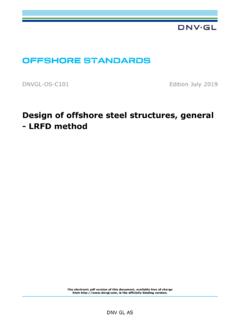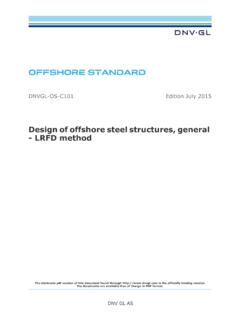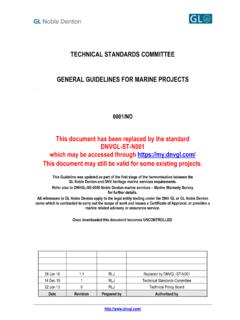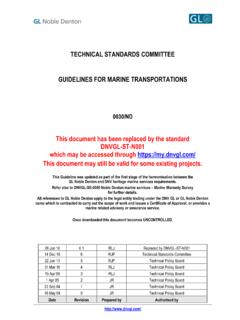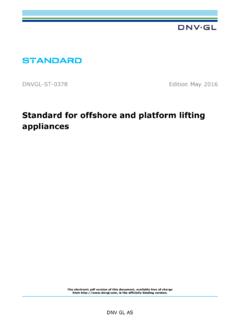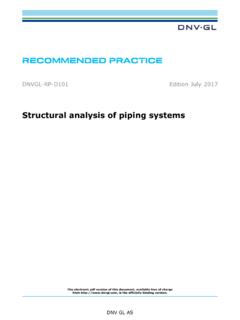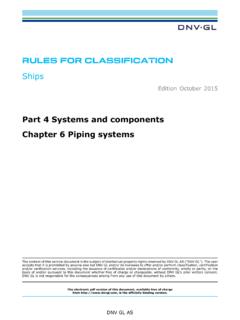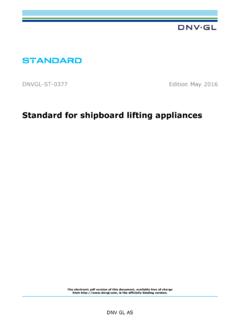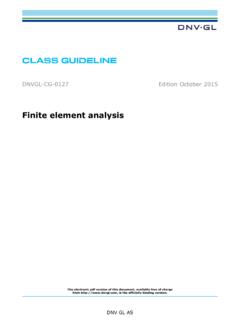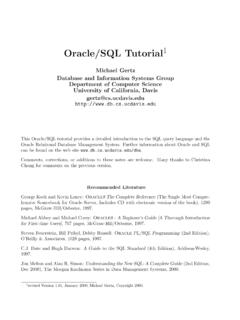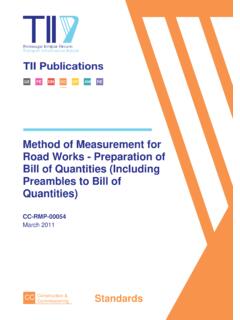Transcription of DNVGL-RU-INV-Pt4Ch3 Pressure vessels
1 RULES FOR CLASSIFICATION. Inland navigation vessels Edition December 2015. Part 4 Systems and components Chapter 3 Pressure vessels The content of this service document is the subject of intellectual property rights reserved by DNV GL AS ("DNV GL"). The user accepts that it is prohibited by anyone else but DNV GL and/or its licensees to offer and/or perform classification, certification and/or verification services, including the issuance of certificates and/or declarations of conformity, wholly or partly, on the basis of and/or pursuant to this document whether free of charge or chargeable, without DNV GL's prior written consent. DNV GL is not responsible for the consequences arising from any use of this document by others. The electronic pdf version of this document, available free of charge from , is the officially binding version.
2 DNV GL AS. FOREWORD. DNV GL rules for classification contain procedural and technical requirements related to obtaining and retaining a class certificate. The rules represent all requirements adopted by the Society as basis for classification. DNV GL AS December 2015. Any comments may be sent by e-mail to If any person suffers loss or damage which is proved to have been caused by any negligent act or omission of DNV GL, then DNV GL shall pay compensation to such person for his proved direct loss or damage. However, the compensation shall not exceed an amount equal to ten times the fee charged for the service in question, provided that the maximum compensation shall never exceed USD 2 million. In this provision "DNV GL" shall mean DNV GL AS, its direct and indirect owners as well as all its affiliates, subsidiaries, directors, officers, employees, agents and any other acting on behalf of DNV GL.
3 CHANGES CURRENT. Part 4 Chapter 3 Changes - current This is a new document. The rules enter into force 1 July 2016. Rules for classification: Inland navigation vessels DNVGL-RU-INV-Pt4Ch3 . Edition December 2015 Page 3. Pressure vessels DNV GL AS. Part 4 Chapter 3 Contents CONTENTS. Changes 3. Section 1 Pressure vessels and heat exchangers, boilers and thermal oil 1 Pressure vessels and heat 5. 2 Steam 3 Thermal oil 21. 4 Oil burners and oil firing Rules for classification: Inland navigation vessels DNVGL-RU-INV-Pt4Ch3 . Edition December 2015 Page 4. Pressure vessels DNV GL AS. SECTION 1 Pressure vessels AND HEAT EXCHANGERS, BOILERS. Part 4 Chapter 3 Section 1. AND THERMAL OIL HEATERS. 1 Pressure vessels and heat exchangers General Scope The following requirements apply to Pressure vessels for the operation of the main propulsion plant and its auxiliary machinery.
4 They also apply to Pressure vessels and equipment necessary for the operation of the inland waterway vessel and to independent cargo tanks if these are subjected to internal or external Pressure in service. Cargo tanks and containers with design temperatures of < 0 C are subject to These requirements do not apply to Pressure vessels with permitted working pressures of up to bar and with a total capacity, without deducting the volume of internal fittings, of not more than 1000 litres, nor to Pressure vessels with working pressures of > 1 bar where the product of Pressure [bar] times capacity [litres] is 200. Manufacture and inspection of these Pressure vessels are subject to the engineering practice. Pressure vessels manufactured to recognized standards can be accepted if they have been subjected in the manufacturer's works to tests conforming to the standard.
5 Division into classes Pressure vessels shall be assigned to classes in accordance with the operating conditions indicated in Table 1. Pressure vessels filled partly with liquids and partly with air or gases or which are blown out with air or gases, such as Pressure tanks in drinking water or sanitary systems and reservoirs, shall be classified as Pressure vessels containing air or gas. Table 1 Pressure vessel classes Operating medium Design Pressure pc [bar]. Design temperature t [ C]. Liquefied gases (propane, butane, etc.), all NA NA. toxic and corrosive media Steam, compressed air, gases, thermal oil pc > 16 pc 16 pc 7. or and and t > 300 t 300 t 170. Liquid fuels, lubricating oils, flammable pc > 16 pc 16 pc 7. hydraulic fluids or and and t > 150 t 150 t 60.
6 Water, non-flammable hydraulic fluids pc > 40 pc 40 pc 16. or and and t > 300 t 300 t 200. Pressure vessel class I II III. NA = not applicable Rules for classification: Inland navigation vessels DNVGL-RU-INV-Pt4Ch3 . Edition December 2015 Page 5. Pressure vessels DNV GL AS. Documents for approval Part 4 Chapter 3 Section 1. Drawings of Pressure vessels , heat exchangers and pressurized equipment containing all the data necessary for their safety assessment shall be submitted to the Society. The following details, in particular, shall be specified: intended use, substances to be contained in the vessel maximum allowable working Pressure and temperatures; if necessary, secondary loads and the volume of the individual Pressure spaces design details of the pressurized parts substance to be contained in the Pressure vessel, working pressures and temperatures materials to be used, welding details, heat treatment.
7 Materials General requirements The materials for Pressure vessels shall be suitable for the intended use and shall comply with Parts such as gussets, girders, lugs, brackets etc. welded directly to Pressure vessel walls shall be made of a material compatible with that of the wall and of guaranteed weldability. Welded structures are also subject to Testing of materials Tests in accordance with are prescribed for materials belonging to Pressure vessel classes I and II used for: a) All surfaces under Pressure with the exception of small parts such as welded pads, reinforcing discs, branch pieces and flanges of nominal diameter DN 32 mm, together with forged or rolled steel valve heads for compressed air receivers b) Forged flanges for service temperatures > 300 C and for service temperatures 300 C if the product of the maximum allowable working Pressure , PB [bar] by the nominal diameter, DN [mm] is < 2500 or the nominal diameter DN is > 250.
8 C) Bolts and nuts of size M 30 (30 mm diameter metric thread) and above made of steels with a tensile 2 2. strength of more than 500 N/mm , or more than 600 N/mm in the case of nuts, and alloy or heat- treated steel bolts above M 16. For class II parts subject to mandatory testing, proof of material quality may take the form of works inspection certificates according to EN 10204 provided that the test results certified therein comply with Works inspection certificates may also be recognized for series-manufactured class I parts made of unalloyed steels, hand- and manhole covers, and for branch pipes where the product of PB DN 2500 and the nominal bore DN 250 mm for service temperatures of < 300 C. For all parts not subject to testing of materials by the Society, alternative proof of the characteristics of the material is to be provided, a works certificate or manufacturer's guarantee as to the properties of the materials used.
9 Manufacturing principles Manufacturing processes applied to materials Manufacturing processes shall be compatible with the materials concerned. Materials whose grain structure has been adversely affected by hot or cold working are to undergo heat treatment in accordance with Rules for classification: Inland navigation vessels DNVGL-RU-INV-Pt4Ch3 . Edition December 2015 Page 6. Pressure vessels DNV GL AS. Welding Part 4 Chapter 3 Section 1. The execution of welding work, the approval of welding shops and the qualification testing of welders shall be in accordance with Reinforcement of openings Due account shall be taken of the weakening of walls caused by openings and, where necessary, reinforcement shall be provided. End plates The flanges of dished ends may not be unduly hindered in their movement by any kind of fixtures, fastening plates or stiffeners.
10 Supporting legs may only be attached to dished ends which have been adequately dimensioned for this purpose. Where covers or ends are secured by hinged bolts, the latter shall be safeguarded against slipping off. Branch pipes The wall thickness of branch pipes shall be so dimensioned as to enable additional external stresses to be safely absorbed. The wall thickness of welded-in branch pipes should be appropriate to the wall thickness of the part into which they are welded. The walls shall be effectively welded together. Pipe connections in accordance with shall be provided for the attachment of piping. Tube plates Tube holes shall be carefully drilled and deburred. Bearing in mind the tube-expansion procedure and the combination of materials involved, the ligament width shall be such as to ensure the proper execution of the expansion process and the sufficient anchorage of the tubes.
